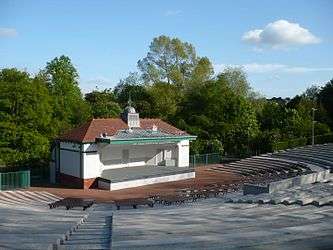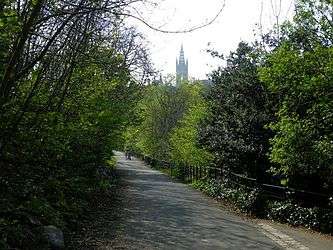Kelvingrove Park
| Kelvingrove Park | |
|---|---|
|
The River Kelvin passing through the park | |
| Type | Public park |
| Location | Glasgow, Scotland |
| Coordinates | 55°52′6″N 4°17′11″W / 55.86833°N 4.28639°WCoordinates: 55°52′6″N 4°17′11″W / 55.86833°N 4.28639°W |
| Area | 34 hectares (85 acres) |
| Created | 1852 |
| Operated by | Glasgow City Council |
| Status | Open all year |
| Public transit access | Kelvinbridge subway station |
Kelvingrove Park is a public park located on the River Kelvin in the West End of the city of Glasgow, Scotland, containing the famous Kelvingrove Art Gallery and Museum.
History
Kelvingrove was originally created as the West End Park in 1852 by noted English gardener Sir Joseph Paxton, Head Gardener at Chatsworth House, whose other works included The Crystal Palace in London. The Town Council had purchased the land, which formerly represented the Kelvingrove and Woodlands estates, that year for the sum of £99,569,[1] around £8 million today.[2] The park was intended to provide for the continued expansion of the city to the west, providing relaxation and recreation opportunities for the new middle class to the west, and an escape from the rapid slumming of the city centre for those left behind.[1]
The Great Exhibitions
The park has been the site of three exhibitions: the 1888 International Exhibition, the 1901 International Exhibition and the 1911 Scottish Exhibition. Large, impressive buildings were constructed in the park for the International Exhibitions, including a large Indian pavilion where the Art Gallery now stands,[3] and a Russian restaurant building.[4] These, however, have since been demolished. The Doulton Fountain at Glasgow Green was originally situated in the park for the 1888 Exhibition but was later relocated.[1]
Location and features
The park is 34 hectares (85 acres) in size,[1] and located in the West End of Glasgow. It straddles the River Kelvin shortly before the river's confluence with the Clyde, and as such is an urban haven for wildlife. Birds found in the area include the grey heron, cormorant, and kingfisher, the mallard and goosander, and other animals include the red fox, brown rat and otters.[5] The park is flanked to the West by Gilmorehill and the University of Glasgow, to the South by Partick and Anderston, to the East by Charing Cross and to the North by Hillhead and Woodlands. This central location makes it a popular route for commuters to the city centre, leading quickly from the West End to Charing Cross whilst avoiding traffic. The park is also popular with dog-walkers, and students from the university.
Kelvingrove sits around the contours of a large hill, on which is sited the Park district of Glasgow. This was formerly a highly desirable residential area before falling out of fashion and being taken over mostly for office space and student accommodation. However, recent high-class residential developments there have made living in the area much more appealing. The area is also home to 22 Park Circus, the city's registry office, and to the Glasgow branch of the Goethe-Institut, a German culture institution.
Kelvinbridge subway station and bus routes provide access to the park.
Monuments

Kelvingrove contains a bandstand, skatepark, bowling and croquet greens, and various statues and monuments. The largest monument is the Stewart Memorial Fountain , built to commemorate Lord Provost Robert Stewart (1851–1854) and his achievement of providing the city with fresh water from Loch Katrine. The fountain was built in 1872 to a design by James Sellars, who later designed the nearby St. Luke's Orthodox Cathedral and Kelvinside Academy. It is built of granite, sandstone, marble and bronze, features imagery of the Trossachs, and is topped by a figure of Sir Walter Scott's Lady of the Lake. The fountain is currently undergoing a half-million pound refurbishment supported by the City Council, Glasgow City Heritage Trust, the Heritage Lottery Fund and Scottish Water.[6]
The park also contains statues of physicist Lord Kelvin, writer Thomas Carlyle, Field Marshal Lord Roberts and chemist Joseph Lister, as well as the Cameronians War Memorial and a memorial to the Highland Light Infantry. The park is popular with dog-walkers and joggers, and is convenient for tourists, being adjacent to Kelvin Hall Sports Arena, on the opposite side of Argyle Street. The park also contains the recently renovated world-renowned Kelvingrove Art Gallery and Museum.
Bandstand
The bandstand within the park was built in 1924 and designed by James Miller. It was a popular location for outdoor music until it became neglected and vandalised around 1995. It played host to thousands of events from military bands to old-time Music Hall acts, Glasgow's first-ever Steel Band Festival to the Radio Clyde Rock Concerts. It was also used for charity fundraising concerts such as the 'Woodlands Fun Days for Children' with Yorkhill Hospital's Radio Lollipop between 1993 and 98.
Scottish bands and musicians such as Belle & Sebastian, Teenage Fanclub, Franz Ferdinand, Eddi Reader, Carol Laula and Horse have all expressed support for the restoration of Kelvingrove Park's Bandstand. MSP Pauline McNeill also presented a motion to the Scottish Parliament about the bandstand restoration.[7] In April 2012 the Scottish Parliament provided a £245,000 building repair grant for the restoration of the bandstand.[8]
On 7 May 2014, after several months and £2 million of restoration work, it was announced that the Bandstand would host a summer music festival over two weekends in August 2014. Acts announced for the Magners Summer Nights Festival were Steve Earle, The Waterboys, Alison Moyet, Capercaillie, Teenage Fanclub and Squeeze.[9][10]
In culture
- The poet, Lyle, wrote a song about the park, entitled Kelvin Grove.[11]
- Much of Alasdair Gray's novel Poor Things takes place in and around the park.
- The Brisbane suburb of Kelvin Grove was named after the park
- The park and Kelvin Way appear in Louise Welsh's novel, The Cutting Room.
Gallery
- Kelvingrove Park
 Vandalised bandstand in 2007, before its restoration in 2013
Vandalised bandstand in 2007, before its restoration in 2013 Bandstand after 2013 refurbishment
Bandstand after 2013 refurbishment The River Kelvin is to the right, with Glasgow University tower in the distance.
The River Kelvin is to the right, with Glasgow University tower in the distance.- The Kelvingrove Museum and Art Gallery
Notes
- 1 2 3 4 Glasgow Museums: History of Kelvingrove Park
- ↑ Measuring Worth - Purchasing Power of British Pound
- ↑ University of Glasgow :: Library :: Glasgow International Exhibition 1888
- ↑ Flickr: Russian Restaurant, Glasgow International Exhibition 1901
- ↑ The Friends of Kelvingrove Park: Environment
- ↑ The Friends of Kelvingrove Park: News
- ↑ Text of Pauline McNeill MSP's Motion to the Scottish Parliament about the Bandstand restoration
- ↑ "Government award grants to upgrade 16 historic buildings". BBC News. 18 April 2012. Retrieved 18 April 2012.
- ↑ http://www.eveningtimes.co.uk/news/u/music-in-the-park-festival-announced-for-kelvingrove-park-bandstand.1399459988
- ↑ http://www.bbc.co.uk/news/uk-scotland-glasgow-west-27309649
- ↑ Friends of Kelvingrove Park: Kelvin Grove song
External links
-
 Media related to Kelvingrove Park at Wikimedia Commons
Media related to Kelvingrove Park at Wikimedia Commons - Location map
- The Friends of Kelvingrove Park
- Kelvingrove Art Gallery and Museum
- Urban Fly fishing on the Kelvin

